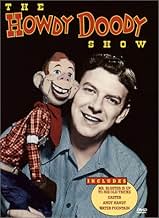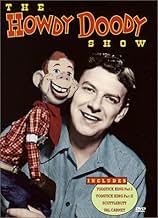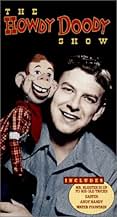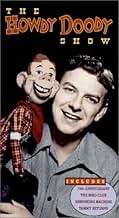El primer programa de televisión infantil estadounidense televisado a nivel nacional y prototipo de lo que vendría después. Buffalo Bob Smith presenta el programa y la marioneta Howdy Doody ... Leer todoEl primer programa de televisión infantil estadounidense televisado a nivel nacional y prototipo de lo que vendría después. Buffalo Bob Smith presenta el programa y la marioneta Howdy Doody lo protagoniza.El primer programa de televisión infantil estadounidense televisado a nivel nacional y prototipo de lo que vendría después. Buffalo Bob Smith presenta el programa y la marioneta Howdy Doody lo protagoniza.
- Nominado a 2 premios Primetime Emmy
- 1 premio ganado y 2 nominaciones en total
Explorar episodios
Opiniones destacadas
I don't think some of those reviewing this show understand that TV was in the process of being born in the late 1940s and early 1950s. You have to take into account that this was the first experiment in kids' TV programming - the very first attempt to do a show that would entertain kids. Radio people, being the only "broadcasters" around, were basically trying to do their thing - but with cameras suddenly on them. Buffalo Bob Smith invented the Howdy Doody character on radio - the puppet we usually see as Howdy was the second version, the first one having been horribly crude. Budgets were next to nothing. When Buffalo Bob asked NBC to add a clown to the show, they turned him down. He hired Bob Keeshan (who later played Captain Kangaroo on his own program) to play Clarabelle the clown and paid him $5 a week out of his own pocket. To appreciate the impact of this show you need to close your eyes and listen to the content. Doodyville is an imperfect world with many surprises. Phineas T. Bluster is the mayor and the authority figure. He frequently does thoughtless things but often comes to see the error of his ways. Watch practically any episode of the hit show NORTHERN EXPOSURE and see the same character interactions! Contrary to several internet posts, Smith was not a ventriloquist. He simply voiced the puppet, Howdy Doody, when he himself was off-camera. At some point, actor Allen Swift took over the voicing of Howdy to facilitate more live interaction between Bob and Howdy. Those who know the reality of the early days of TV recognize Bob Smith as one of TV's founding geniuses for his insight into children's entertainment.
I watched this show everyday when I was a child in the '50s. I was even on the show once as a member of the 'Peanut Gallery'. Kids need more of this type of programming today and less of the pseudo violence and political programming that is labeled as 'kids TV' today. This stirs imagination, which in turn stirs creativity in children. The actors were wholesome people. Bob Keeshan who played 'Clarabell the Clown' for several years, later became successful as 'Captain Kangaroo'. Bob Smith who was also known as 'Buffalo Bob' did a lot of touring and public appearances. He was kind to children, I remember the day that I got to be in the 'Peanut Gallery', I was 8, Buffalo Bob was kind and not at all flustered by a bunch of young children. He seemed to really like kids.
I first saw "Puppet Playhouse" at the age of 5 on a neighbor's 5-inch GE TV (with a magnifying glass over the screen so that we could all see it). At that time, I lived near Buffalo, NY. Buffalo Bob's constant references to places around Buffalo brought the context a little closer. Then there were the old time movies, featuring Mickey McGuire and the Tons of Fun.
I also watched The Camel News Caravan, I Remember Mama, Milton Berle and all sorts of programs which stimulated my curiosity and imagination. And all this without the benefit of special effects that are now available. And, more importantly, a lot more imagination at play, than one would find in later years.
Years later when I'm watching my children watch cartoon characters flying around with devastating rays coming from their bare hands, I quickly devise ways to get the kids away from this stuff. My opinion is that (like another commenter) is that my kids missed some pretty neat stuff.
I also watched The Camel News Caravan, I Remember Mama, Milton Berle and all sorts of programs which stimulated my curiosity and imagination. And all this without the benefit of special effects that are now available. And, more importantly, a lot more imagination at play, than one would find in later years.
Years later when I'm watching my children watch cartoon characters flying around with devastating rays coming from their bare hands, I quickly devise ways to get the kids away from this stuff. My opinion is that (like another commenter) is that my kids missed some pretty neat stuff.
Catchy jingle at the beginning of the end of each episode is sure to have you bounding around the house singing. I like the interaction with the kids in the audience. There's some coaching but often kids give some very creative and funny responses. The old timey movie in the show is some goofy fun thrown into the mix. Puzzles and games provide interactive fun.
There was a bit of showboating the network which seemed awkward, but better than modern TV ads. The theme for the show tends to get a little lost in all the hoopla, but there is an attempt to tie it in and bring the theme back to the point. We can see how this definitely a template for future children's television programming.
There was a bit of showboating the network which seemed awkward, but better than modern TV ads. The theme for the show tends to get a little lost in all the hoopla, but there is an attempt to tie it in and bring the theme back to the point. We can see how this definitely a template for future children's television programming.
MIGOSH! WHERE DO we begin? It's truly incredible to think of how much we really do recall about a series of so long ago. It is even more unbelievable when one considers that when we viewed much of this, the age was about 4 or 5 years old!
IT WAS AN important part of the afternoon routine at the Ryan household of 1950 (when we got our first TV set) to 1952 (we moved into our won house) and beyond. Because of this early and elementary introduction, the show and its characters had a very profound effect on our development.
ODDLY ENOUGH, DUE to our family's explanation of things, we understood that all we saw on the show was make believe. Our Mom and Dad, as well as older Sister Joanne, clued us in as to the fact that the people we saw were Actors, who portrayed the participants of the festivities on the show.
AND WHAT A GRAND cast of characters it truly was! In addition to the marionette main character, Howdy Doody, himself, there were a number of other supporting puppets. The action was provided by: Mr. Phineas T. Bluster (Howdy's elderly nemesis), Flubadub (a crazy-quilt of an animal*), Dilly Dally (a lackadaisical boy), Captain Scuttlebutt (Dilly Dally's uncle and Tugboat Operator) and others.
LIVE ACTION REAL actors who were featured mainly consisted of some whom portrayed multiple roles. For example, we have: Judy Tyler** as Indian Princess Summerfall Winterspring, Robert Keeshin (Future Captain Kangaroo) as the original Clarabelle the Clown and Chief Featherman of the Tinka-Tonka tribe (the Princess'father), with Bill Le Cornec taking the versatility honors with a triple assignment of renegade Chief Thunderthud (of the Ooragnak tribe & often ally of Mr. Bluster), Dr. Singasong (visiting 'trubador' and look alike for Mandrake the Magician) as well as Oil Well Willie (old coot of a Prospector).
THERE ARE CERTAIN incidents that we well remember, without benefit of any refresher. There was a continuity called "The Search for the Golden Goat" (a treasure hunt).
THE SHOW'S MOVING from the original Howdy Doody Circus setting to "Doodyville" was particularly memorable, if mean spirited. In it, Howdy said that Mr. Bluster could have the Circus for his own. But as that day's show was closing, a wrecking crew was "tearing down" the set! Can you say "CRUELTY?"
THE CREATOR, ONE 'Buffalo Bob' Smith served as host and did have some time off for recuperation from a heart attack (when he was temporarily replaced with one 'Bison Bill') Although Bob (born Robert Schmidt) sported a costume that was patterned after a buckskin outfit, he was not truly a man of the Old West. He derived the name from having been born and raised in Buffalo, NY!
THE ENTERPRISING AND versatile Mr. Smith also provided the voice for the wooden-headed Howdy!
NOTE: * The "Flubadub" was a combination of many animals; having the ears of a cocker spaniel, flippers of a turtle, etc. It was sort of like a fictional version of a Platypus!
NOTE ** Judy Tyler was killed in a car accident in 1957. At age 24 she was just embarking on a promising career; having just co-starred with Elvis in JAILHOUSE ROCK!
IT WAS AN important part of the afternoon routine at the Ryan household of 1950 (when we got our first TV set) to 1952 (we moved into our won house) and beyond. Because of this early and elementary introduction, the show and its characters had a very profound effect on our development.
ODDLY ENOUGH, DUE to our family's explanation of things, we understood that all we saw on the show was make believe. Our Mom and Dad, as well as older Sister Joanne, clued us in as to the fact that the people we saw were Actors, who portrayed the participants of the festivities on the show.
AND WHAT A GRAND cast of characters it truly was! In addition to the marionette main character, Howdy Doody, himself, there were a number of other supporting puppets. The action was provided by: Mr. Phineas T. Bluster (Howdy's elderly nemesis), Flubadub (a crazy-quilt of an animal*), Dilly Dally (a lackadaisical boy), Captain Scuttlebutt (Dilly Dally's uncle and Tugboat Operator) and others.
LIVE ACTION REAL actors who were featured mainly consisted of some whom portrayed multiple roles. For example, we have: Judy Tyler** as Indian Princess Summerfall Winterspring, Robert Keeshin (Future Captain Kangaroo) as the original Clarabelle the Clown and Chief Featherman of the Tinka-Tonka tribe (the Princess'father), with Bill Le Cornec taking the versatility honors with a triple assignment of renegade Chief Thunderthud (of the Ooragnak tribe & often ally of Mr. Bluster), Dr. Singasong (visiting 'trubador' and look alike for Mandrake the Magician) as well as Oil Well Willie (old coot of a Prospector).
THERE ARE CERTAIN incidents that we well remember, without benefit of any refresher. There was a continuity called "The Search for the Golden Goat" (a treasure hunt).
THE SHOW'S MOVING from the original Howdy Doody Circus setting to "Doodyville" was particularly memorable, if mean spirited. In it, Howdy said that Mr. Bluster could have the Circus for his own. But as that day's show was closing, a wrecking crew was "tearing down" the set! Can you say "CRUELTY?"
THE CREATOR, ONE 'Buffalo Bob' Smith served as host and did have some time off for recuperation from a heart attack (when he was temporarily replaced with one 'Bison Bill') Although Bob (born Robert Schmidt) sported a costume that was patterned after a buckskin outfit, he was not truly a man of the Old West. He derived the name from having been born and raised in Buffalo, NY!
THE ENTERPRISING AND versatile Mr. Smith also provided the voice for the wooden-headed Howdy!
NOTE: * The "Flubadub" was a combination of many animals; having the ears of a cocker spaniel, flippers of a turtle, etc. It was sort of like a fictional version of a Platypus!
NOTE ** Judy Tyler was killed in a car accident in 1957. At age 24 she was just embarking on a promising career; having just co-starred with Elvis in JAILHOUSE ROCK!
¿Sabías que…?
- TriviaThis was the first nationally televised American children's television show.
- Citas
[final episode. Clarabell speaks for the only time in the show's history]
Clarabell the Clown: Goodbye, kids.
- ConexionesFeatured in Television Land (1971)
Selecciones populares
Inicia sesión para calificar y agrega a la lista de videos para obtener recomendaciones personalizadas
- How many seasons does The Howdy Doody Show have?Con tecnología de Alexa
Detalles
- Fecha de lanzamiento
- País de origen
- Idioma
- También se conoce como
- The Howdy Doody Show
- Locaciones de filmación
- Productora
- Ver más créditos de la compañía en IMDbPro
- Tiempo de ejecución30 minutos
- Mezcla de sonido
- Relación de aspecto
- 1.33 : 1
Contribuir a esta página
Sugiere una edición o agrega el contenido que falta

Principales brechas de datos
What is the Spanish language plot outline for Puppet Playhouse (1947)?
Responda




























